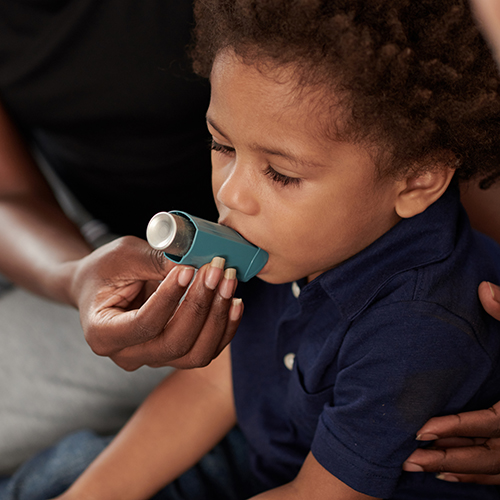September 2024
Asthma is a chronic lung disease that causes breathing problems. People with asthma typically have a small amount of swelling inside their airways. This makes them more susceptible to asthma triggers, such as allergens, exercise, pollutants, or illness.
Once triggered, the airways can swell even more—and may also produce excess mucus. Both can make it harder for air to move in and out of the lungs. When this happens, you may experience difficulty breathing, shortness of breath, coughing, wheezing, and tightness in your chest.
A flare-up of difficulty breathing like this is what people commonly refer to as an “asthma attack.” However, not all asthma is the same. According to the American Lung Association, there are several different types of asthma, and a person with asthma can suffer from multiple types.
Learn more about the different types of asthma and how to keep each one under control. Your local pharmacist can be a great resource to help you manage your asthma and put your asthma action plan into practice.
Allergic asthma
With allergic asthma, asthma attacks are triggered when you breathe in an allergen. Allergens are typically harmless to humans, but the immune system reacts as if they are harmful. This immune system overreaction leads to swelling and mucus production, triggering an asthma attack. Allergic asthma is the most common type of asthma.
How to reduce allergic asthma attacks: First, know your triggers. Common triggers include mold, pollen, pet dander, and dust mites. An allergist can help you determine which ones are the most serious for you—and help you make a plan to reduce your exposure to them.
Aspirin-induced asthma
Aspirin-induced asthma is a type of asthma triggered by aspirin and other non-steroidal anti-inflammatories (NSAIDs), such as ibuprofen.
About 10% of people with asthma have aspirin-induced asthma. People with this type of asthma will typically experience respiratory problems within 30 minutes to 3 hours after taking an NSAID. The problem is most common in people who have chronic asthma and nasal polyps.
How to reduce aspirin-induced asthma attacks: If you suspect you have aspirin-induced asthma, talk to your doctor. They can confirm whether you have this type of asthma, help you find alternatives to NSAIDs for pain relief, and help you develop a plan for how to safely take NSAIDs if need be.
Cough-variant asthma
Cough-variant asthma is a type of asthma where the only symptom is a dry cough. It can be harder to recognize because coughs can be a symptom of a variety of conditions. If you wonder if your dry cough is cough-variant asthma, ask yourself these questions:
- Does your cough grow worse after exercising?
- Does your cough grow worse in cold, dry weather?
- Does exposure to allergens (such as pet dander, pollen, mold, or dust) trigger a bout of coughing?
- Does coughing interrupt your sleep?
If the answer is yes to one or more of these questions, ask your doctor if you might have cough-variant asthma.
How to manage cough-variant asthma: The biggest risk with cough-variant asthma is that it will progress to full-blown asthma. In fact, about 30% of people with cough-variant asthma will go on to develop classic asthma. However, working with a doctor to properly manage cough-variant asthma can help prevent this progression.
Exercise-induced asthma
For some people with asthma, exercise or other physically demanding activities can trigger an asthma attack. This type of asthma is called exercise-induced asthma.
How to reduce exercise-induced asthma attacks: If you experience asthma symptoms regularly during or after physical exertion, talk to your doctor about changes to your asthma action plan that may help reduce your breathing problems when you exert yourself.
Nighttime asthma
Nighttime (or nocturnal) asthma is exactly what it sounds like—asthma that gets worse at night. If you wake up at least one night per week due to asthma symptoms, you likely have nighttime asthma. Roughly three-quarters of people with asthma report this problem.
How to reduce nighttime asthma: As with other types of asthma, work with your doctor to develop an asthma action plan to control your symptoms. In addition, take steps to reduce your exposure to asthma triggers while you sleep. For example, if you’re allergic to animals, keep them out of your bedroom. If you’re allergic to dust mites, invest in dust mite covers for your pillows and mattress, and remove carpeting if you can. If you’re allergic to pollen, keep your windows closed at times when pollen counts are high.
Occupational asthma
Also known as workplace asthma, occupational asthma is a type of asthma that occurs due to exposure to workplace triggers. Any job where you’re exposed to particulates or chemicals in the air can potentially trigger occupational asthma. Triggers can include animal dander, dust, and pollen. Signs that you may have occupational asthma include the following:
- Symptoms worsening at work
- Symptoms worsening as the week progresses
- Symptoms improving when you go home
- Symptoms improving over the weekend



